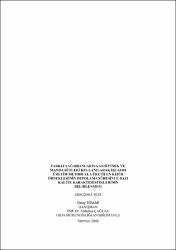| dc.contributor.advisor | Çağlar, Abdullah | |
| dc.contributor.author | Tomar, Oktay | |
| dc.date.accessioned | 2019-05-28T12:38:28Z | |
| dc.date.available | 2019-05-28T12:38:28Z | |
| dc.date.issued | 2015 | |
| dc.date.submitted | 2015 | |
| dc.identifier.uri | http://hdl.handle.net/11630/6259 | |
| dc.description.abstract | Bu çalışmada; farklı yağ oranlarında inek ve manda sütüyle kefir danesi veya kefir kültürü kullanılarak üretilen kefirlerin, 4 °C de 21 günlük depolama sırasındaki kimyasal, organik asit (laktik asit, asetik asit, sitrik asit), aroma bileşenleri (asetaldehit, aseton, etil asetat, etanol, diasetil), renk değerleri (L*, a*, b*), mikrobiyolojik kalitesi (Lactobacillus, Lactococcus, Leuconostoc, L. acidophilus ve maya sayıları) ve duyusal özellikleri üzerine etkisi incelenmiştir.
Örneklerin kurumadde, protein içeriği ve pH dereceleri depolama boyunca düşmüştür (p<0,05). Kefir örneklerinin titrasyon asitliği depolamanın 1. gününde % 0,68-0,88 arasında bulunmuş ve örneklerin titrasyon asitliği depolama süresince azalmıştır (p<0,05). Örneklerin karbondioksit içerikleri üretim metodu ve süt çeşidine göre değişiklik göstermiştir (p<0,05). Manda sütü ve kefir danesi kullanılarak üretilen örneklerde, starter kültür ile üretilen örneklere göre daha yüksek karbondioksit içeriği saptanmıştır (p<0,05). Örneklerin tirozin içerikleri, depolamanın 14 günü boyunca artmış, inek sütü ile üretilen kefirler hariç depolama sonunda azalmıştır. Depolamanın tüm aşamalarında örneklerin viskozite değerleri düşmüştür.
Starter kültür ile üretilen kefir örneklerinin laktik asit ve asetik asit içerikleri kefir danesi ile üretilenlere göre daha yüksek olarak tespit edilmiştir (p<0,05). Kefir örneklerinin depolama başlangıcındaki propiyonik asit ve sitrik asit değerleri, sırasıyla 13,54-32,54 μg/g ve 610-1750 µg/g arasında değişmiş ve depolama süresince azalış göstermiştir.
Örneklerin asetaldehit, aseton, etil asetat konsantrasyonları depolama sırasında artmıştır (p<0,05). İnek sütü ve dane ile üretilen kefir örnekleri daha yüksek oranda asetaldehit, aseton ve etil asetat içeriğine sahiptir (p<0,05). Kefir üretiminde kefir danesi kullanımı starter kültür kullanımına göre daha yüksek alkol oluşturmaktadır. Düşük yağlı manda sütü ve kefir danesi kullanılan örneklerde daha yüksek etanol içeriği saptanmıştır. Manda sütü ile üretilen kefir örneklerinde yüksek oranda L*, a* değerleri ve düşük oranda b* değerleri bulunmuştur.
Lactobacillus, Lactococcus, Leuconostoc, ve maya sayıları 14 günlük depolama boyunca artış göstermiş, depolama süresinin sonuna doğru ise azalmıştır (p<0,05). L. acidophilus sayısı tüm depolama boyunca düşmüştür (p<0,05). Duyusal analiz sonuçlarına göre tam yağlı inek sütü (İD-30) ve manda sütünden (MD-30) kefir danesi ile kullanılarak üretilen kefirler daha yüksek genel beğeni kazanmıştır. | en_US |
| dc.description.abstract | In this study, the effects of cow and buffalo milks with different levels of fat using kefir grains or kefir culture on the chemical, organic acids (lactic acid, acetic acid, sitric acid, propionic acid), aroma components (acetaldehyde, acetoin, ethyl acetate, ethanol, diacetyl), color values (L*, a*, b* values), microbiological characteristics (Lactobacillus, Lactococcus, Leuconostoc, L. acidophilus and yeast) and sensory properties of kefir were investigated during storage for 21 day 4 °C.
Dry matter, protein content and pH degree of all samples were decreased (p<0,05) throughout storage. The titratable acidity values of the kefir samples were found in the range of 0,68 to 0,88 % at day 1 and titratable acidity of samples were increased during to storage periods. CO2 content of the kefir samples showed significant differences due to production methods and milk species (p<0,05). Production with kefir grains and buffalo milk higher (p<0,05) CO2 content in kefir than production with kefir starter culture. The tyrosine content of kefir samples were increased during to 14 day of storage and decreased end of the storage except kefir produced with cow milk. In all samples viscosity value were decreased during storage periods.
Lactic acid and acetic acid contents of kefir samples produced with starter culture (p<0,05) higher than kefir samples produced with grain. At the beginning of the storage, the propionic acid and citric acid levels of the kefir samples were varied 13,54-32,54 μg/g and 610-1750 µg/g, respectively and increased throughout storage.
The concentration of acetaldehyde, acetoin, ethyl acetate increased during storage periods (p<0,05). The kefir samples produced with cow milk and grains had higher acetaldehyde, acetoin, ethyl acetate content (p<0,05). Production with kefir grains provided higher (p<0,05) ethanol content in kefir than production with kefir starter culture and the highest ethanol content was found in kefir produced with low-fat buffalo milk and kefir grain. Kefir samples produced buffalo milk had the highest L* or a* values and the lowest b* values during the storage.
The counts of Lactobacillus, Lactococcus, Leuconostoc and yeast increased significantly (p<0,05) until 14 day of storage and declined at the end of the storage but L. acidophilus counts decreased all periods of the storage (p<0,05). According to sensory analysis result kefir produced with whole fat cow milk (İD-30) or buffalo milk (MD-30) and kefir grain were most like and preferred. | |
| dc.language.iso | tur | en_US |
| dc.rights | info:eu-repo/semantics/openAccess | en_US |
| dc.subject | İnek Sütü | en_US |
| dc.subject | Manda Sütü | |
| dc.subject | Kefir | |
| dc.subject | Yağ Oranı | |
| dc.title | Farklı yağ oranlarına sahip inek ve manda sütleri kullanılarak iki ayrı üretim metoduyla üretilen kefir örneklerinin depolama süresince bazı kalite karakteristiklerinin belirlenmesi | en_US |
| dc.title.alternative | Determination of some quality characteristics of kefir produced with cow and buffalo milk with different fat levels by using two production methods | en_US |
| dc.type | doctoralThesis | en_US |
| dc.department | Afyon Kocatepe Üniversitesi, Fen Bilimleri Enstitüsü | en_US |
| dc.relation.publicationcategory | Tez | en_US |



















